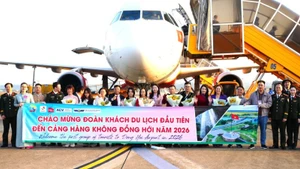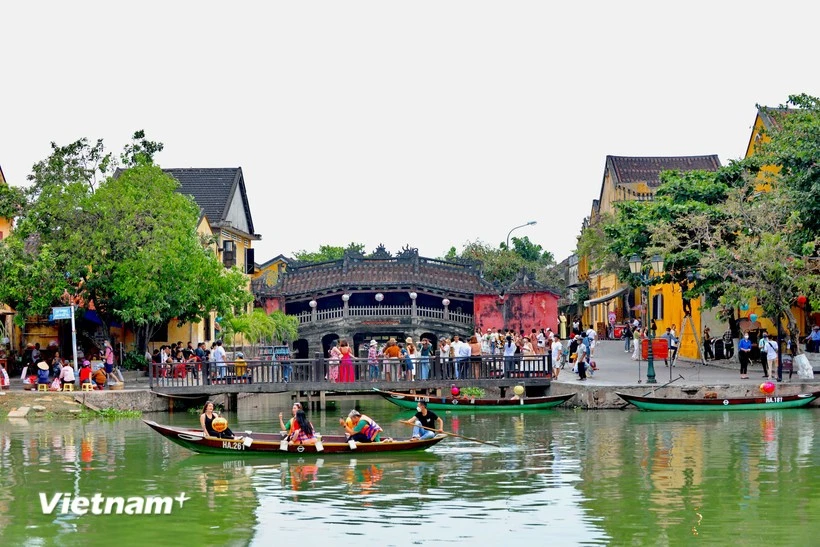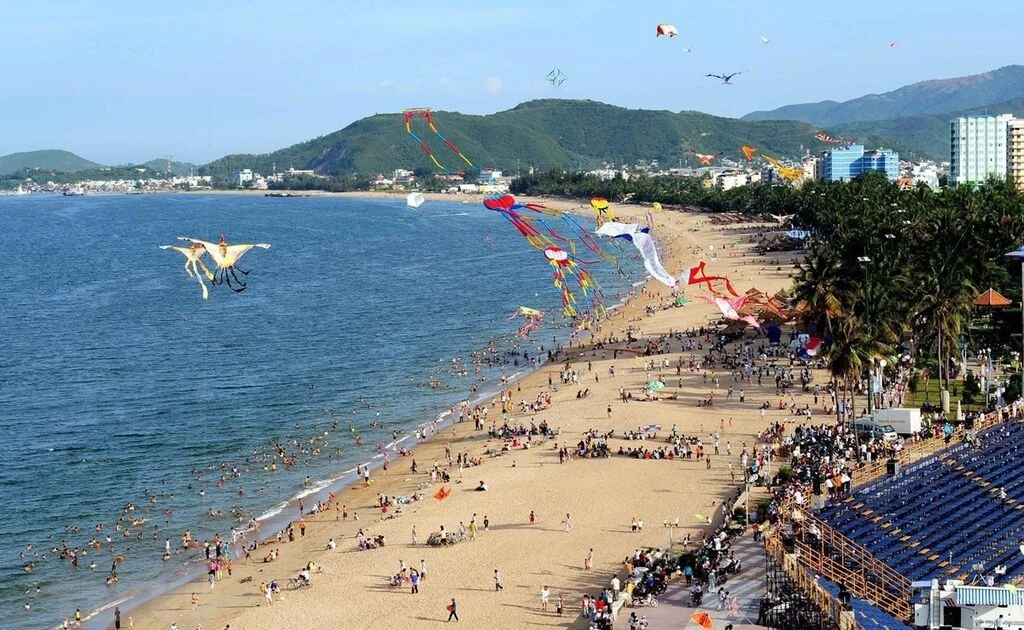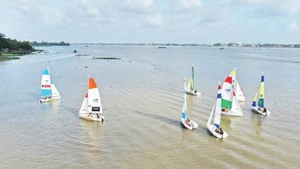However, the smokeless industry still has a lot of work to do in 2023 and the following years to reach its goal of full recovery to pre-pandemic levels by 2025.
The tourism sector has set a target of serving 60 million domestic tourists and five million international visitors in 2022.
Impressive comeback and the boom of domestic tourism
After more than two years of stagnation, since its full reopening on March 15, 2022, Vietnamese tourism has been like a spring that has been suppressed for a long time and has popped up fully. The industry has recovered impressively and quickly reaped positive results. Domestic tourism recovered strongly with 12 million tourists in May 2022 and 12.2 million visits in June. Following six months, the tourism sector welcomed 60.6 million domestic travelers, exceeding the target of 60 million set for the whole year of 2022. The total number of domestic tourists reached 96.3 million in the first 11 months of the year, surpassing all forecasts and far exceeding 85 million domestic tourists in 2019 (before the pandemic). However, the international tourism segment has recovered slowly. Vietnam only welcomed over 2.95 million foreign arrivals in the first 11 months, reaching more than 50% of the target of five million visitors this year. Compared with Thailand, which has welcomed its 10 millionth international tourist on December 10, the recovery of Vietnamese tourism is still very slow.
However, it is good news that total revenue from tourists is estimated at 456.7 trillion VND across the first 11 months of this year, equivalent to 70% that of the same period in 2019.
According to the Vietnam National Administration of Tourism,, 95% of travel businesses stopped their operation, 35% applied to withdraw their business licenses, 90% of tourist accommodation establishments were closed and the annual average capacity of rooms was only 5% in 2021. In 2022, more than 70% of accommodation establishments have returned to normal operation and room occupancy on weekends and on holidays averaged 40%-50% and about 70%, respectively. Localities and enterprises have been proactive in the organisation of many festivals and carnivals, creating many highlights promoting tourism activities.
The prospect of recovery of businesses in the tourism sector has been clearer as the number of businesses returning to operation increased sharply, with 2,362 enterprises in accommodation and catering services and 2,215 others in tourism services. A series of high-class resorts and modern entertainment areas in destinations were officially put into operation in 2022, demonstrating their ability to overcome difficulties and belief in the quick recovery of Vietnamese tourism enterprises.
Forecast and breakthrough for the full recovery of tourism
Besides the full reopening of tourism, many conferences and seminars were held in 2022 to discuss the industry’s development following COVID-19 with many forecasts and calculations about the recovery rate and tourism development scenarios for Vietnam’s tourism. The general assessment affirms that the pandemic has been well controlled in Vietnam, so its socio-economic industries, including tourism, have recovered and developed rapidly. However, the country’s tourism sector is also facing many difficulties and challenges. In particular, businesses are facing a severe lack of financial resources to restore, expand and develop physical, technical and tourism infrastructure in localities and destinations. The fluctuations and displacement of human resources during the fight against the pandemic have caused the lack of both high-quality human resources and unskilled workers. The long-standing weaknesses of Vietnamese tourism must be deeply re-evaluated for a complete solution. It is important to forecast the speed of tourism recovery, give the most feasible scenarios to restructure the tourism economy in the overall economic structure of localities, and overcome the situation of "hot" growth that has disrupted current planning in localities.
2023 will continue to be a difficult year due to new challenges such as the conflict between Russia and Ukraine, the impact of the global economic recession, the increasingly fierce competition among destinations in the same region and the discretion in reopening from several important markets of Vietnam. According to the Vietnam National Administration of Tourism, each international visitor spent about 2.9 million VND per day on average while a domestic tourist spent 1.2 million VND in 2022. In the next few years, the spending capacity of both domestic and international tourists will not increase due to post-COVID consequences. However, spending capacity will gradually increase when the economy recovers, people’s income improves and tourism services are more diversified and have higher quality.
On the basis of an analysis of the domestic and international contexts, the Vietnam National Administration of Tourism has proposed three development scenarios (options) for Vietnam tourism including low growth, medium growth and high growth. Of which, the medium growth scenario is preferred thanks to its highest feasibility. Accordingly, Vietnam tourism has set a target of fully recovering as it was before the pandemic (welcoming 18 million international visitors and 116 million domestic tourists) by 2025. Due to the increasing competition among the countries in the field of tourism, the tourism industry needs more strategies to attract visitors such as loosening its visa policies, promoting the destination to international friends, and carefully managing destinations towards creating a beautiful image of Vietnam.
It is forecasted that tourism activities in the world and in the country will gradually recover and develop again in 2023 and the following years. Although opportunities for international tourist flows have come and travel is very convenient, the crises of the world economy that have affected the people’s income and the fear of the epidemic will cause limitations in people's ability to travel. In 2023, international visitors to Vietnam will increase, but the number of visitors has not been able to recover and reach thresholds like 2019. Therefore, Vietnam needs to focus on exploiting markets that have reopened and restored air connectivity. In addition, it is crucial to promote investment strongly to attract emerging markets with great potential and prospects such as India and the Middle East while exempting tourist visas for citizens from European countries, Australia, New Zealand, Canada and the US and extending the stay period for tourists who receive tourist visa exemption to 30 days.
Vietnam has controlled the pandemic well, so thanks to identifying the domestic tourism market as the focus and focusing on exploiting this market will surely grow again and recover quickly in 2023. However, it is also necessary to promote a new mindset that the spending is more important than the number of visitors. Spending by domestic tourists averaged 977,700 VND per day in 2011 but reach only 1.15 million VND per day in 2020, a very slow increase in the context of rapid annual inflation.
Therefore, it is essential to promote the application of digital technology and innovative thinking, renewing the ways to access the market and develop products to bring more added value than the period before the pandemic. Besides the popular tourism forms such as sea tourism, spiritual cultural tourism, festivals, urban tourism and culinary tourism, new trending tourism product lines such as such as luxury resorts, health care, medical treatment, eco-tourism, sport tourism and smart travel need to be developed.
The above forecasts and identification of breakthrough require the efforts from the Government and localities in boosting the development of transport infrastructure, accommodation facilities, amusement parks, entertainment, construction and development of new tourism products in line with trends while strengthening the promotion and communication of tourism services. Hopefully, with the determination and consensus of businesses and the support from management agencies, local authorities, Vietnamese tourism will soon fully recover.
















